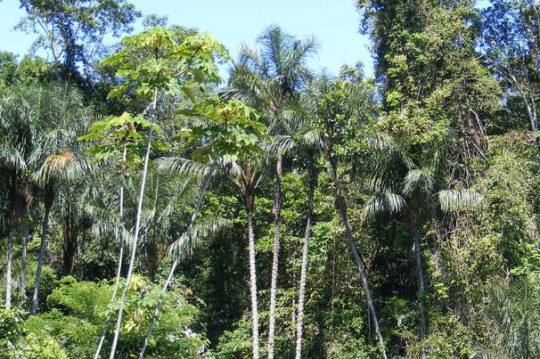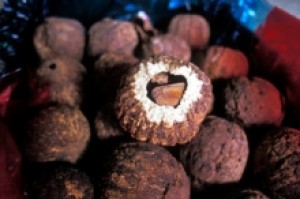UN book highlights benefits of Amazon plants and foods to improve livelihoods
UN book highlights benefits of Amazon plants and foods to improve livelihoods
 Amazon Rainforest
Amazon Rainforest
A United Nations book released today aims to provide people in the developing world with accessible knowledge of Amazon plants and foods they can use to improve their livelihoods.
The book, Fruit Trees and Useful Plants in Amazonian Life, is written in easy-to-grasp language and incorporates the folklore and customs of rural villagers so they can easily put the book’s recommendations into practice.
“Some 80 per cent of people living in the developing world rely on non-wood forest products such as fruits and medicinal plants for their nutritional and health needs,” said Eduardo Rojas-Briales, Assistant Director-General for Forestry at the Food and Agriculture Organization (FAO).
Some 80 per cent of people living in the developing world rely on non-wood forest products such as fruits and medicinal plants for their nutritional and health needs.
“This new book provides comprehensive information on Amazon fruits and plants, and is a perfect example of how to make our knowledge accessible for poor people to help them maximize the benefits from forest products and services and improve their livelihoods.”
FAO estimates that 25 per cent of people in developing countries are functionally illiterate, and that in rural areas this figure can be of up to 40 per cent. The layout of the book takes this into account and allows readers who lack formal education to extract knowledge using pictures and numbers.
“Some 90 Brazilian and international researchers who were willing to present their research to rural villagers in alternative formats – including jokes, recipes and pictures – collaborated in the production of this book,” said Tina Etherington, who managed the publication project for FAO’s forestry department.
Ms. Etherington also highlighted that farmers, midwives, hunters and musicians contributed insights and their experiences to the publication, making it an “innovative way of presenting science and how those techniques can be transferred to other areas in the world.”
Some of the foods spotlighted in the publication that provide nutrients, minerals and anti-oxidants that keep the body healthy include the Buriti palm fruit, which contains the highest known levels of vitamin A of any plant in the world and the açaí fruit, which is hailed as a “superfood” for its high antioxidant and omega fatty acid content.
The publication was co-produced by FAO, the Centre for International Forestry Research (CIFOR) and People and Plants International, and was unveiled in a ceremony in Rome marking the end of the International Year of Forests.
The Amazon is the largest contiguous tropical forest remaining in the world, with 25 million people living in the Brazilian Amazon alone. However, deforestation, fire and climate change could destabilize the region and result in the forest shrinking to one third of its size in 65 years.
###
Book on Amazon plants puts science in the hands of people
FAO marks end of International Year of Forests with new study on useful plants from the Amazon
20 December 2011, Rome – A new FAO study released today shows how plants and fruits from Amazonian forests can be used to improve people’s diets and livelihoods. The book — which is written in easy-to-grasp, accessible language — seeks to take science out of the ivory tower and put it to work on the ground, in the hands of people.

In the Brazilian Amazon, Brazil nuts are a valuable source of calories, fat and protein for much of the rural and urban population.
Fruit Trees and Useful Plants in Amazonian Life was co-produced by the UN Food and Agriculture Organization (FAO), the Center for International Forestry Research (CIFOR) and People and Plants International. It was unveiled today during a ceremony at FAO marking the close of the International Year of Forests.
“During the International Year of Forests we have managed to highlight close ties between people and forests, as well as the numerous benefits that forests provide if they are managed by local communities in a sustainable way,” said Eduardo Rojas-Briales, FAO’s Assistant Director-General for Forestry.
“Some 80 percent of people living in the developing world rely on non-wood forest products such as fruits and medicinal plants for their nutritional and health needs. This new book provides comprehensive information on Amazon fruits and plants, and is a perfect example of how to make our knowledge accessible for poor people to help them maximize the benefits from forest products and services and improve their livelihoods. While the International Year of Forests is almost over, our efforts on promoting sustainable forest management and the importance of involving forest communities in development initiatives will continue,” added Rojas-Briales.
Unique approach
The layout of FAO’s new book aims at allowing readers lacking in formal education to extract knowledge using pictures and numbers. Twenty five percent of people in developing countries are functionally illiterate — in rural areas this figure can reach close to 40 percent.
“Some 90 Brazilian and international researchers who were willing to present their research to rural villagers in alternative formats — including jokes, recipes and pictures — collaborated in the production of this book,” said Tina Etherington, who managed the publication project for FAO’s Forestry Department. “And a number of farmers, midwives, hunters and musicians contributed valuable insights and experience as well. The book is of interest to a worldwide audience because of its truly innovative way of presenting science and how those techniques can be transferred to other areas in the world.”
Patricia Shanley, Senior Research Associate at CIFOR and lead editor of the publication, said: “This is an unusual book. Written by and for semi-literate rural villagers, it weaves together a tapestry of voices about the myriad values forests contain.”
“The book enables nutritional data and ecology to coexist alongside music and folklore making the forest and its inhabitants come alive,” she added.
Marina Silva, former Minister of the Environment of Brazil, who wrote the preface to the book, noted: “This book is an extraordinary poem to Amazonia”.
Forests and food at risk
The Amazon is the largest contiguous tropical forest remaining in the world, with 25 million people living in the Brazilian Amazon alone. However, deforestation, fire and climate change could destabilize the region and result in the forest shrinking to one third of its size in 65 years, according to today’s publication.
In addition to the environmental services they provide, forests like the Amazon are also a rich nutritional storehouse. Fruits provide essential nutrients, minerals and anti-oxidants that keep the body strong and resistant to disease. Buriti palm fruit, for example, contains the highest known levels of vitamin A of any plant in the world. And açaí fruit is being hailed as a “superfood” for its high antioxidant and omega fatty acid content. Brazil nuts are rich in a complete protein similar to the protein content of cow’s milk, which is why they are known as the “meat” of the plant kingdom, said the publication.
###
> UN Food and Agriculture Organization (FAO).
The Food and Agriculture Organization of the United Nations (FAO) is an intergovernmental organization and has 191 Member Nations, two associate members and one member organization, the European Union. Achieving food security for all is at the heart of FAO’s efforts – to make sure people have regular access to enough high-quality food to lead active, healthy lives.

FAO’s mandate is to raise levels of nutrition, improve agricultural productivity, better the lives of rural populations and contribute to the growth of the world economy.
The Food and Agriculture Organization of the United Nations (FAO) is working with its Members and the entire international community for achievement of the Millennium Development Goals.
These eight goals – each with specific targets and indicators – are based on the United Nations Millennium Declaration, signed by world leaders in September 2000. They commit the international community to combating poverty, hunger, disease, illiteracy, environmental degradation, and discrimination against women.
![]()
The eight Millennium Development Goals are:
Goal 1: Eradicate extreme poverty and hunger
Goal 2: Achieve universal primary education
Goal 3: Promote gender equality and empower women
Goal 4: Reduce child mortality
Goal 5: Improve maternal health
Goal 6: Combat HIV/AIDS, malaria and other diseases
Goal 7: Ensure environmental sustainability
Goal 8: Develop a Global Partnership for Development
* More information at UN Food and Agriculture Organization (FAO)
###
> United Nations (UN).
 The United Nations was established on 24 October 1945 by 51 countries committed to preserving peace through international cooperation and collective security. Today, nearly every nation in the world belongs to the UN: membership totals 192 countries.
The United Nations was established on 24 October 1945 by 51 countries committed to preserving peace through international cooperation and collective security. Today, nearly every nation in the world belongs to the UN: membership totals 192 countries.
When States become Members of the United Nations, they agree to accept the obligations of the UN Charter, an international treaty that sets out basic principles of international relations. According to the Charter, the UN has four purposes:
- to maintain international peace and security;
- to develop friendly relations among nations;
- to cooperate in solving international problems and in promoting respect for human rights;
- and to be a centre for harmonizing the actions of nations.
###
* The above story is adapted from materials provided by United Nations (UN)
** More information at United Nations (UN)






















